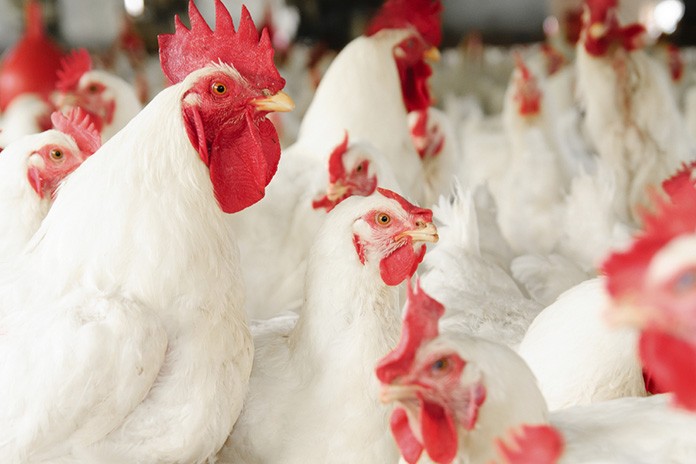
The obligatory elimination of AGP by the European Union and the voluntary removal of these drugs in the US have resulted in a worldwide search for raising broilers antibiotic-free. Some potential alternatives that have been tested include probiotics, prebiotics, organic acids, and plant extracts.
Today’s consumers have been gaining an interest in animal practices with more attention given to animal health and wellbeing, nutrition, food safety and production systems. Majority of the poultry industry depends on the use sub-therapeutic levels of Antibiotic Growth Promoters (AGP) to improve weight gain, feed efficiency and production, whereas avoiding enteric health problems in today’s animal feeding operations. The main function of the digestive system is to absorb broken down nutrients from the diet to support Animal health and growth. With this complicated process in the gastro-intestinal tract (GIT), the digestibility of ingredients, utilization of nutrients and Animal health are greatly influenced by the microflora in the digestive tract. Nutritionists focus on modifying various processes to improve digestion and animal health to product a high quality and safe product for human consumption. The microorganisms within the digestive tract vastly exceed the numbers of cells in the body, so the main goal is to maintain a good microbial balance to limit pathogen proliferation inside the intestine. With continuous use of AGP in animal feed, a resistance to antibiotics has been reported in a few strains of E.Coli. The beneficial effects of using antibiotics in animal feeds are linked to the modification of the intestinal bacteria and their interaction with the host animal. Therefore, some families of intestinal microflora are not only improving nutrient utilization along the gastro intestinal tract, but also supporting animal health and production. The obligatory elimination of AGP by the European Union and the voluntary removal of these drugs in the US have resulted in a worldwide search for suitable alternatives to AGP in poultry diets. Some potential alternatives that have been tested include probiotics, prebiotics, organic acids, and plant extracts.
Probiotics are one class of alternatives being considered to fill the gap with the removal of AGP. Today, resistance of intestinal bacteria to antibiotics and the increased governmental and consumer attention on the use of AGP, forced the European Union to ban the use of AGP in 2006, while the United States has gradually reduced the use of antibiotics in poultry diets. To have a better understanding of raising poultry without antibiotics we have to go back to basic management of poultry. Best management practices include a well-developed biosecurity and vaccination program, and best management practices documented and in use. A good nutrition program with proven and consistent high quality feed additives and finally breeder health and hatching egg managements all need to be scrutinized.
Top 7 important practices to raise chickens without antibiotics
– Strict down-time between placements: Operation with minimum 14 days downtime with good clean-out (bird clear out & litter cake removed). Depends on your production practices down-time should start when birds are out of the house.
– Optimum stocking density: Increase a 0.05 ft2/bird compared to your current conventional program, to help keep litter moisture at a minimum, which in turn reduces the shedding of cocci-oocyst and pathogenic bacteria over population. Industry Stocking density have been in continuous debate. A study by Bilgili and Hess (1995) examining three densities of 0.8, 0.9 or 1.0 square foot per bird. In the study they found a significantly improvement when birds were given more space when looking at body weight, feed conversion, mortality, carcass scratches and breast meat yield.
– Good litter management: Dryness of litter and ammonia level are a big key success in raising poultry. Litter sanitation and treatments when using build-up litter need more attention with littler amendment. A well-documented research on the negative impact of ammonia on bird performance was reported. Using litter amendment and adequate ventilation are the most practical way to control ammonia and improve littler quality. In addition build-up litter consider as a community of microbes of various types and composition. Total litter cleanout is much recommended least once a year.
– Control environment housing: Including temperature, humidity, and air quality. Adequate ventilation is a key in controlling house environment quality. Genetic companies provide a well documents information on temperature, humidity and air quality for raising broiler. Dust is an excellent carrier of bacteria and mold are potential source of Infection. Antibiotic resistant bacteria have been reported in broiler chicken air. Airborne dispersion of Antibiotic resistant bacteria should not be underestimated considering poultry respiratory health & poultry workers in the farm.
– Pre-Starter feed: it’s important to establish good gut microbial population to achieve a balance in gut microbiota (such as using Probiotics, prebiotics, organic acids, short and Medium chain fatty acid, and phytogenic) for nutritional enhancement of GI tract, boost immune development, and facilitate nutrients absorption. Also a special attention to feed particle size, protein & fat quality, & specific additives.
– Water quality and sanitation: Marinating a good water sanitation program is a key to poultry production. Water is the most important nutrition for the birds. A routine water quality analysis for bacteria, pH, hardness, minerals and total dissolved solid should be conducted yearly. Flushing and disinfecting between flocks as well as during flocks with good quality disinfected that allow the removal of pipe line build-up biofilm. Biofilms are a sticky film that can be find inside water lines, regulators, and nipple drinkers and can be composed of bacteria and other organisms. Chlorine is the most popular sanitizer, however there are other well documented sanitizer that includes hydrogen peroxide, chlorine dioxide, and ozone. In addition, Acidifiers are used to improve the effectiveness of the sanitizer and reduce bacterial growth in water lines.
– Feed additive alternatives: Alternatives such as probiotics, prebiotics, organic acids, and enzymes have been considered and studied to prevent NE in recent years. Hofacre et al. conducted several studies using probiotics to demonstrate the reduction of NE lesions. Hofacre and others reported a reduction in mortality rates from 60% to 30% in day-old chicks. Probiotics microorganisms such as Lactobacillus, Bacillus subtilis, and Bacillus licheniformis significantly improved immune response and antibody production when fed to broilers, improve production performance, increase microbial balance, improve feed consumption when fed to both broilers and layers and lower the gut pH and the release bacteriocins. Although many articles in the current scientific literature refer to the “beneficial effects” of probiotics, some of the articles are often unclear on what benefits are provided to the animal.
In conclusion, the demand for poultry meat as one of the most important sources of animal protein is rapidly increasing as the world population continues to grow. Infections caused by pathogenic microorganisms can be of major concern for farm family’s involved in poultry production. Pathogenic E-coli, Salmonella, and Clostridium are responsible for reduced growth rates and increased cost of production. Traditionally, AGP have been used commonly in poultry feeds to maintain the health of chickens and turkeys. Unfortunately, the long term and extensive use of antibiotics results in selection and survival of resistant microbial species, therefore, posing a threat to the health of both animals and humans. Consequently, some countries have restricted the use of AGP in poultry. Since probiotics do not result in the development and spread of microbial resistance, they offer the potential to become an alternative to antibiotics. Several feed additive could be successfully used as nutritional tools in antibiotic free poultry feeds for promotion of growth, modulation of intestinal microflora and pathogen inhibition, immunomodulation and promoting meat quality of poultry.
From the Proceedings of the 2016 Midwest Poultry Federation Convention.

















